
A bumblebee is any of over 250 species in the genus Bombus, part of Apidae, one of the bee families. This genus is the only extant group in the tribe Bombini, though a few extinct related genera are known from fossils. They are found primarily in higher altitudes or latitudes in the Northern Hemisphere, although they are also found in South America, where a few lowland tropical species have been identified. European bumblebees have also been introduced to New Zealand and Tasmania. Female bumblebees can sting repeatedly, but generally ignore humans and other animals.

Bombus fraternus is an endangered species of bumblebee known commonly as the Southern Plains bumblebee. It is native to the United States east of the Rocky Mountains. It is most often encountered in the Southeast, in areas with sandy soil. They range from New Jersey to Florida, North Dakota, South Dakota, Nebraska, Colorado, and New Mexico. There has been a bee found in Chihuahua, Mexico It is uncommon today, having faced declines in population; its estimated abundance is less than 15% of historical numbers.

Bombus melanopygus, the black-tailed bumble bee, black tail bumble bee or orange-rumped bumblebee, is a species of bumblebee. It is native to western North America from British Columbia to California, and as far east as Idaho.
Bombus polaris is a common Arctic bumblebee species. B. polaris is one of two bumblebees that live above the Arctic Circle. The other is its social parasite Bombus hyperboreus. B. polaris is a social bee that can survive at near freezing temperatures. It has developed multiple adaptations to live in such cold temperatures. B. polaris has a thicker coat of hair than most bees, utilizes thermoregulation, and makes insulated nests.
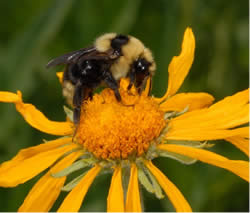
Bombus insularis is a species of bumblebee in the subgenus Psithyrus, the cuckoo bumblebees. It is native to northern and western North America, where it occurs throughout Canada, Alaska, the northern United States, and some western states. It is known commonly as the indiscriminate cuckoo bumblebee.

Bombus suckleyi is a species of bumblebee known commonly as Suckley's cuckoo bumblebee, named after biologist George Suckley. Suckley's bumble bee is a generalist pollinator and represents a rare group of obligate, parasitic bumble bees. Suckley's bumble bee is a social-parasite because it invades the nests of the host bumble bees, including the western bumble bee, and relies on host species workers to provision its larvae. It is native to northwestern North America, including Alaska and parts of western and central Canada and the western United States.

Bombus pensylvanicus, the American bumblebee, is a threatened species of bumblebee native to North America. It occurs in eastern Canada, throughout much of the Eastern United States, and much of Mexico.

Bombus cryptarum is a species of bumblebee. It is native to the northern hemisphere, where it is "one of the most widespread bumblebees in the world." It occurs throughout Europe, Asia, and western North America. It is known commonly as the cryptic bumblebee.
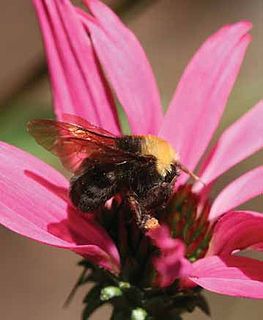
Franklin's bumblebee is known to be one of the most narrowly distributed bumblebee species, making it a critically endangered bee of the western United States. It is known only from a 190-by-70-mile area in southern Oregon and northern California, between the Coast and Sierra-Cascade mountain ranges. It was last seen in 2006. Franklin's bumblebee is known to collect nectar and pollen from several wildflowers, such as lupine, California poppy, and horsemint, which causes it to be classified as a generalist forager.
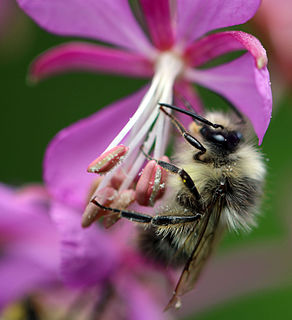
Bombus mixtus is a species of bumblebee. It is native to western North America, where it occurs in western Canada and the United States. It is also disjunct in the Great Lakes region. It is known commonly as the fuzzy-horned bumblebee, tricoloured bumblebee, orange-belted bumblebee, and mixed bumblebee.
Apicystis is a genus of parasitic alveolates of the phylum Apicomplexa.

Bombus appositus is a species of bumblebee known commonly as the white-shouldered bumblebee. It is native to western North America, including western Canada and the western United States.
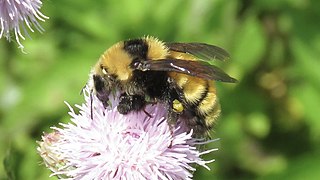
Bombus borealis is a species of bumblebee known commonly as the northern amber bumblebee. It is native to northern North America, where it occurs across Canada and Alaska and the northern and eastern contiguous United States.

Bombus griseocollis is a species of bumblebee known commonly as the brown-belted bumblebee. It is native to much of the United States except for the Southwest, and to the southernmost regions of several of the provinces of Canada.
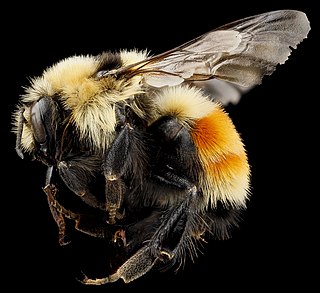
Bombus huntii is a species of bumblebee. It is native to western North America, where it occurs in western Canada and the United States as far east as Manitoba and Minnesota, and in Mexico as far south as the Trans-Mexican Volcanic Belt. It is known commonly as the Hunt bumblebee or Hunt's bumblebee.
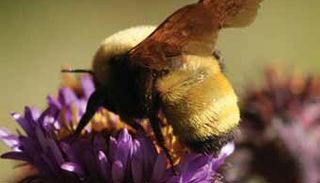
Bombus morrisoni is a species of bumblebee. It is native to western North America, including the western United States and British Columbia. It is known commonly as the Morrison bumblebee.
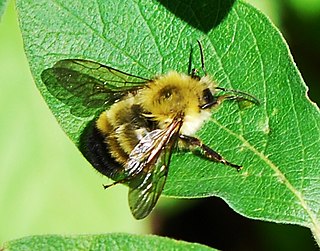
Bombus perplexus is a species of bumblebee known by the common name confusing bumblebee. It is native to northern North America, where it occurs across Canada and into the eastern United States.
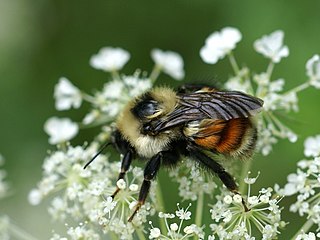
Bombus rufocinctus is a species of bumblebee known commonly as the "red-belted bumblebee." It is native to North America where it has a wide distribution across Canada and the western, midwestern, and northeastern United States. It may occur in Mexico.

Bombus sandersoni is a species of bumblebee known commonly as the Sanderson bumblebee. It is native to North America, where it occurs across Canada and in the eastern United States.

Bombus sylvicola is a species of bumblebee native to North America. It occurs throughout most of Canada, its distribution extending into Alaska and the western contiguous United States. In the southernmost extent of its range in California it occurs only at elevation. It is known commonly as the forest bumblebee.


















